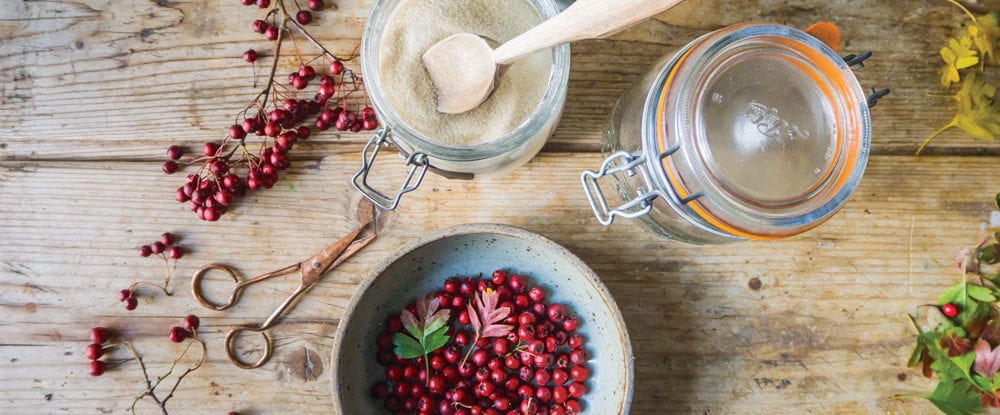Exclusive Recipe from Making Winter
Posted on: 07/11/2017 with tags Exclusives

Hawthorn Gin
Hawthorn is one of the most common shrubs growing in hedgerows and scrubland in temperate areas of Europe, America and Asia. It’s a member of the rose family and, like most varieties of rosehips, hawthorn berries (also known as haws) ripen in September and October. Gathering them in order to make a delicious liqueur for consumption as winter gathers pace is no chore. There are often clear, crisp sunny days during autumn, and venturing out to gather haws can make an autumnal walk even lovelier.
This recipe can also be used to make delicately fragranced and deliciously sharp rosehip gin. Wild rosehips from hedgerows are perfect for this. It is best to avoid taking rosehips from neighbours’ gardens in case of grumpy recriminations. However, offering a bottle of rosehip gin in return for this harvest seems like an excellent solution.
When the sun goes down and the weather is gruesome, find a cosy spot, light some candles, find a good book (this one would do very well indeed), pour a small glass of one of these fine home-made, hedgerow berry-infused liquids and nestle down. There will soon be a glow within and without.
Materials
- One or more 500ml or 1lt (17 or 34fl oz) jars with lever seals e.g. Kilner or Weck (it’s crucial that the jars are airtight when closed)
- Sharp scissors
- Funnel
- Muslin, 1m (3ft.) square is more than enough
Ingredients
- Hawthorn berries – enough to fill your jar(s)
- Gin (supermarket own-brands are fine) – enough to fill your jar(s)
- White or golden granulated or caster sugar – around 400g (14oz) for a 1l (34fl oz) jar and 200g (9oz) for a 500ml (17fl oz) jar
Note: The seeds inside the hawthorn berries can be poisonous, so don’t be tempted to sample the berries.
Step by Step
1: Collect enough haw berries to fill the jar in which you plan to make your gin.
2: Wash the berries and, with a pair of sharp scissors, remove any stalks and dried remains of the flower from the end of each berry. As haws are quite small this can take some time, so pop a film or box set on or listen to the radio while you top and tail them.
3: While you are preparing your haws, you can sterilize your jar. If your jar has a rubber seal, remove it and put to one side. Set your oven to140°C/275°F/gas 1, wash your jar in hot soapy water thoroughly, place it on a baking tray (preferably upside down) and put it in the oven for around 10 minutes, then remove from the oven and allow to cool. Try not to touch the inside of your jars before you make your gin. Boil the rubber seal for 10 minutes in a saucepan of water.
4: Once they’re free of their stalks and flower remains, tumble a layer of haws into your jar around 3cm (1½in.) thick. Pour in around a quarter of your sugar.
5: Add another layer of haws, top with sugar and repeat this process until you have filled the jar.Now pour in your gin.
6: Once you’ve filled your jar to the top, seal it, upend carefully a couple of times in case air has become trapped between the haw berries, and then top up with more gin to minimize the gap between the surface of the gin and the lid.
7: Place your gin on a kitchen shelf out of direct sunlight or in a cupboard for 4–6 weeks. After this time the colour from the berries will have seeped into the gin resulting in a beautiful pink, rosé wine colour.

Making Winter
by Emma Mitchell
Banish winter blues and embrace the frosty months by cosying up with Emma Mitchell’s nature-inspired collection of crafts.
Buy from Amazon

